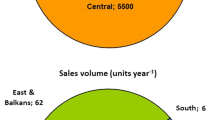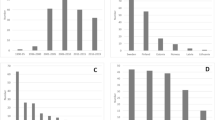Abstract
A survey of harvesting contracts was conducted in the Alpine regions of France and Italy. The main goal was to produce a benchmark for the harvesting contract rates in the area that may guide forest owners and logging contractors when making their harvesting decisions. The sample included 443 contracts, evenly distributed between France and Italy. The mean tract size was 9.17 ha, while the mean lot size was slightly larger than 500 m3 under bark (ub). Mean removal intensity varied from 70 to 120 m3 ub ha−1, depending on country and harvesting technique (i.e. ground-based or cable-yarder based). Mean contract rate was 35€ m−3 ub, but individual contract rates varied significantly between countries and for different harvest techniques. Regression analysis showed that contract rate was strongly affected by tree size, extraction distance and harvest technique. Contrary to expectation, neither tract size nor lot size had any effect on contract rate. This may be explained by the widespread use of mobile operations that are specifically designed for handling small lots and incur minimum relocation cost. The technical factors explored in the study could only explain 40 % of the variability in the dataset, and therefore at least part of the variability must derive from non-technical factors such as local market dynamics and national economics. The study did find significant differences between countries. In particular, ground-based operations were more cost efficient in France, and cable yarder-based operations in Italy.



Similar content being viewed by others
References
Baker S, Greene D (2012) Factors affecting logging costs and contract rates. In: Proceeding of the conference of the Council on Forest Engineering; 2012 Sep 12; New Bern, NC
Binder C, Hofer C, Wiek A, Scholz R (2004) Transition towards improved regional wood flows by integrating material flux analysis and agent analysis: the case of Appenzell Ausserrhoden, Switzerland. Ecol Econ 49:1–17
Brandl H (2006) Farms in the black forest of Baden-Württemberg: a historical review. Small-scale For Econ Manag Pol 5:145–159
Buttoud G (2002) Multipurpose management of mountain forests: which approaches? For Pol Econ 4:81–162
Conrad J, Bolding C, Aust M, Smith R, Horcher A (2013) Harvesting productivity and costs when utilizing energywood from pine plantations of the southern Coastal Plain USA. Biomass Bioenerg 52:85–95
CTBA (2004) Technical guide on harvesting and conservation of storm damaged timber. CTBA, Paris (France), p 105. www.stodafor.org
Cubbage F, Greene D (1989) Conventional and biomass harvesting costs by forest tract size. Biomass 20:219–228
Cubbage F, Harou P, Sills E (2007) Policy instruments to enhance multi-functional forest management. For Pol Econ 9:833–851
Dimou V, Malivitsi Z (2015) Strategic decision model for the evaluation of timber harvesting systems. Int J For Eng 26:146–157
Dorren L, Berger F, Imeson A, Maier B, Rey F (2004) Integrity, stability and management of protection forests in the European Alps. For Ecol Manag 195:165–176
EU Agri-info (2016) European wages. http://www.agri-info.eu/english/t_wages.php
EU Energy portal (2016) Energy prices. http://www.energy.eu/fuelprices/
Ferrari E, Spinelli R, Cavallo E, Magagnotti N (2012) Attitudes towards mechanized cut-to-length technology among logging contractors in northern Italy. Scand J For Res 27:800–806
Gerasimov Y, Sokolov A, Syunev V (2013) Development trends and future prospects of cut-to-length machinery. Adv Mater Res 705:468–473
Ghaffariyan M, Naghdi R, Ghajar I, Nikooy M (2013) Time prediction models and cost evaluation of cut-to-length (CTL) harvesting method in a mountainous forest. Small Scale For 12:181–192
Greene D, Harris T, DeForest C, Wang J (1997) Harvesting cost implications of changes in the size of timber sales in Georgia. South J Appl For 21:193–198
Grulois S (2007) Cable yarding in France: past, present and perspectives. In: Sessions J, Havill Y Proceedings of the International Mountain Logging and 13th Pacific Northwest Skyline Symposium. Corvallis, OR (USA), p 299
Harrison S, Herbohn J, Niskanen A (2002) Non-industrial, smallholder, small-scale and family forestry: what’s in a name? Small-scale For Econ Manag Pol 1:1–11
Hunziker M, Felber P, Gehring K, Buchecker M, Bauer N, Kienast F (2008) Evaluation of landscape change by different social group. Mount Res Dev 28:140–147
IRE (2015) Listino dei prezzi all’ingrosso (Price list of bulk commodities). Chamber of Commerce, Industry, Crafts and Agriculture of Bolzano. Bullettin 5/2015. Bolzano (Italy), p 24
Kittredge D, Thompson J (2016) Timber harvesting behaviour in Massachusetts, USA: does price matter to private landowners? Small-scale For 15:93–108
Kittredge D, Mauri M, McGuire E (1996) Decreasing woodlot size and the future of timber sales in Massachusetts: when Is an operation too small? North J Appl For 13:96–101
Klaus M, Holsten A, Hostert P, Kropp J (2011) Integrated methodology to assess windthrow impacts on forest stands under climate change. For Ecol Manag 261:1799–1810
Koch S, Schwarzbauer P, Stern T (2013) Monthly wood supply behavior of associated forest owners in Austria—Insights from the analysis of a micro-econometric panel. J For Econ 19:331–346
L’Roe A, Allred S (2013) Thriving or surviving? Forester responses to private forestland parcelization in New York State. Small-scale For 12:353–376
Magagnotti N, Nati C, Pari L, Spinelli R, Visser R (2011) Assessing the cost of stump-site debarking in eucalypt plantations. Biosys Eng 110:443–449
Magagnotti N, Kanzian C, Schulmeyer F, Spinelli R (2013) A new guide for work studies in forestry. Int J For Eng 24:249–253
Mason B, Kerr G, Simpson J (1999) What is continuous cover forestry? Forestry Commission Information Note 29. Forestry Commission, Edinburgh
Melemez K, Tunay M, Emir T (2014) A comparison of productivity in five small-scale harvesting systems. Small-scale For 13:35–45
Merlo M (1995) Common property forest management in Northern Italy: historical and socio-economic profile. Unasylva 46:58–63
Moldenhauer M, Bolding C (2009) Parcelization of South Carolina’s private forestland: loggers’ reactions to a growing threat. For Prod J 59:37–43
Motta R, Nola P, Piussi P (2002) Long-term investigations in a strict forest reserve in the eastern Italian Alps: spatio-temporal origin and development in two multi-layered subalpine stands. J Ecol 90:495–507
Oliveira E, Seixas F (2012) Energy analysis of two eucalyptus harvesting systems in Brazil. Proceedings of the 35th Council of Forest Engineers Annual Meeting. Sept. 9–12, 2012. New Bern, North Carolina (USA), p 7
Onida M (2009) The Alps: eight countries, a single territory. Permanent Secretariate of the Alpine Convention, Innsbruck (Austria), p 89
Oswald K, Riechsteiner D, Thees O, Lemm R (2004) Reorganisation of wood production for improved performance: a swiss forest district case study. Small-scale For Econ Manag Pol 3:143–160
Pellegrini M, Grigolato S, Cavalli R (2013) Spatial multi-criteria decision process to define maintenance priorities of forest road network: an application in the Italian alpine region. Croat J For Eng 34:31–42
Perlik M, Messerli P (2004) Urban strategies and regional development in the Alps. Mount Res Dev 24:215–219
Ruch P, Fraichot J, Ginet C, Heliot P, Laurier J, Mendow N (2010) Bilan et perspectives pour le parc de machines d’exploitation forestière en Bourgone. Rapport final du projet B00399. FCBA, Paris, p 68
Schelhaas M, Hengeveld G, Moriondo M, Reinds G, Kundzewicz Z, Maat H, Bindi M (2010) Assessing risk and adaptation options to fires and windstorms in European forestry. Mitig Adapt Strateg Glob Change 15:681–701
Seidl R, Rammer W, Lexer M (2011) Climate change vulnerability of sustainable forest management in the Eastern Alps. Climat Change 106:225–254
Spinelli R, Magagnotti N (2011) The effects of introducing modern technology on the financial, labour and energy performance of forest operations in the Italian Alps. For Pol Econ 13:520–524
Spinelli R, Magagnotti N (2013) The effect of harvest tree distribution on harvesting productivity in selection cuts. Scand J For Res 28:701–709
Spinelli R, Magagnotti N, Facchinetti D (2013) A survey of logging enterprises in the Italian Alps: firm size and type, annual production, total workforce and machine fleet. Int J For Eng 24:109–120
Spinelli R, Di Gironimo G, Esposito G, Magagnotti N (2014) Alternative supply chains for logging residues under access constraints. Scand J For Res 29:266–274
Spinelli R, Visser R, Thees O, Sauter H, Krajnc N, Riond C, Magagnotti N (2015) Cable logging contract rates in the Alps: the effect of regional variability and technical constraints. Croat J For Eng 36:195–203
Stuart W, Grace L, Grala R (2010) Returns to scale in the Eastern United States logging industry. For Pol Econ 12:451–456
Urquhart J, Courtney P (2011) Seeing the owner behind the trees: a typology of small-scale private woodland owners in England. For Pol Econ 13:535–544
Visser R (2010) Methodologies for setting timber harvesting (logging) rates. N Z J For 55:10–11
Zambelli P, Lora C, Spinelli R, Tattoni C, Vitti A, Zatelli P, Ciolli M (2012) A GIS decision support system for regional forest management to assess biomass availability for renewable energy production. Environ Model Softw 38:203–213
Acknowledgments
This study is a part of the project “Organization and rationalization of logging operations” funded by Regione Autonoma Friuli-Venezia Giulia, Servizio Gestione Forestale e Produzione Legnosa and managed by CESFAM—Centro Servizi per le Foreste e le Attività della Montagna. Special thanks are due to Dott. M. Di Gallo and Dott. R. Comino for their support with study planning and data collection.
Author information
Authors and Affiliations
Corresponding author
Rights and permissions
About this article
Cite this article
Spinelli, R., Visser, R., Riond, C. et al. A Survey of Logging Contract Rates in the Southern European Alps. Small-scale Forestry 16, 179–193 (2017). https://doi.org/10.1007/s11842-016-9350-1
Accepted:
Published:
Issue Date:
DOI: https://doi.org/10.1007/s11842-016-9350-1




